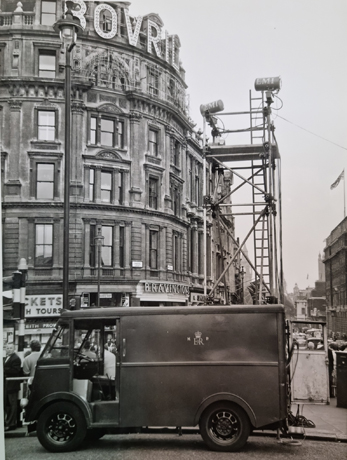The Metropolitan Police experimented with the very earliest closed-circuit television (CCTV) throughout the 1960s, without much to show for it. It has parallels with how the police are trialling automatic face recognition, using vastly more sophisticated video, in the 2020s.
The story in a file at the National Archives, Mepo 2/9956, begins in June 1960, when senior police had ‘a preliminary discussion’ with PE Betteridge, of EMI Electronics, ‘the producers of the equipment which is at present being used for traffic control at West Drayton’. The next month, the king and queen of Thailand were making a two-day state visit to Britain. This was, police noted, ‘a good opportunity to stage a demonstration as the equipment can be used for the arrival ceremony on July 19 and for the state drive to the Guildhall on the 20th.’ One rotating camera would give a view of the Mall, Whitehall and Northumberland Avenue; and the other facing in the direction of Charing Cross Road, ‘so as to give a view of a considerable part of Trafalgar Square’. Both would be installed on King Charles Statue Island, in Trafalgar Square. Each would have its own monitor in an EMI van standing in the road by the island.
The trial suited police and electronics firm alike. “Mr Betteridge has said that his company will demonstrate an installation of this kind free of charge and without obligation.” Days later an assistant Met commissioner minuted to the deputy commissioner, ‘I would very much like to try out the usefulness of closed-circuit television in connection with ceremonial events and possible major demonstrations etc in Trafalgar Square’.
From the beginning, then, the Met had the policing of trouble in mind; and an uncontentious royal visit was a handy occasion. The deputy commissioner replied: ‘I saw this apparatus at work at Ryton and it was quite interesting. It has great potentiality with crowds and demonstrations and could prove very valuable to us.’ The deputy commissioner was referring to an even earlier use of CCTV, from a rival firm, Pye, at West Drayton, the winter before. A main road only had one-way traffic during work on a bridge; the two places where traffic had to stop for the oncoming cars to pass were out of sight to each other. Thanks to a CCTV camera at one end, a man with a monitor at the other end worked the traffic lights.
For the Thai visit the cameras would be mounted on 20-foot scaffolding. Everything about public space surveillance, long taken for granted, had to be worked out. On the first day, when the camera had to look towards sunshine, the reflection off the road spoilt the image on the screen. On the second day, in torrential rain, both cameras eventually broke down.
One policeman judged afterwards, ‘it seems to me a great pity that EMI did not provide lenses of better quality and in view of the weather protected by guards and wipers’. It was striking that police were not put off; ‘if Mr Betteridge is given another chance, I am sure that he will spare no efforts next time!’
A Met commander had indeed suggested another demo: ‘EMI might be asked to provide better camera lenses capable of picking out individuals and protected against vagaries of the weather. Great importance is attached to adequate communication and another demonstration on the lines envisaged would provide an opportunity of trying out he equipment with RT [radio-telephone] communication between camera points and monitors’.
Police did not feel that CCTV would solve any problems in crowd or traffic control, ‘except in circumstances such as the West Drayton road widening sceme where there is a distinct saving in manpower. Nevertheless it does seem that it might be a most useful adjunct at such places as Twickenham and Wembley and indeed on ceremonial and other occasions to give a much fuller appreciation at a central point and enable a quicker assessment to be made as regards the necessity for deploying reserves etc generally’. CCTV, then, would ‘supplement rather than substitute’ men on the ground; cameras were an aid for those in charge.
Another senior policeman who saw the state visit demonstration on both days ‘was disappointed with the quality of the picture. This evidently can be remedied.’ He too was thinking in terms of saving manpower at ceremonials and ‘potentially disorderly meetings and the like’, adding, ‘I know of no substitute for the experienced police eye on the spot and the ability to sense trouble in the air. If we are to have the usual Guy Fawkes rabble in Trafalgar Square on November 5 I would like a further demonstration of closed-circuit television’. That night would qualify as the ‘varied conditions’ police wanted to test CCTV under.
A conference of assistant commissioners in September 1960 duly noted Bonfire Night for the trial in Trafalgar Square, where police had a ‘viewing box’, described by one commanders as ‘very confined and may well not prove very suitable for the experiment’. The police and EMI sought to place cameras inside buildings facing the Square, such as Canada House.
Photo courtesy of the National Archives; beneath an advertising hoarding for Bovril, in Trafalgar Square, the July 1960 pioneering use of CCTV, and unmarked monitoring van.
Continued: part two on this link.









